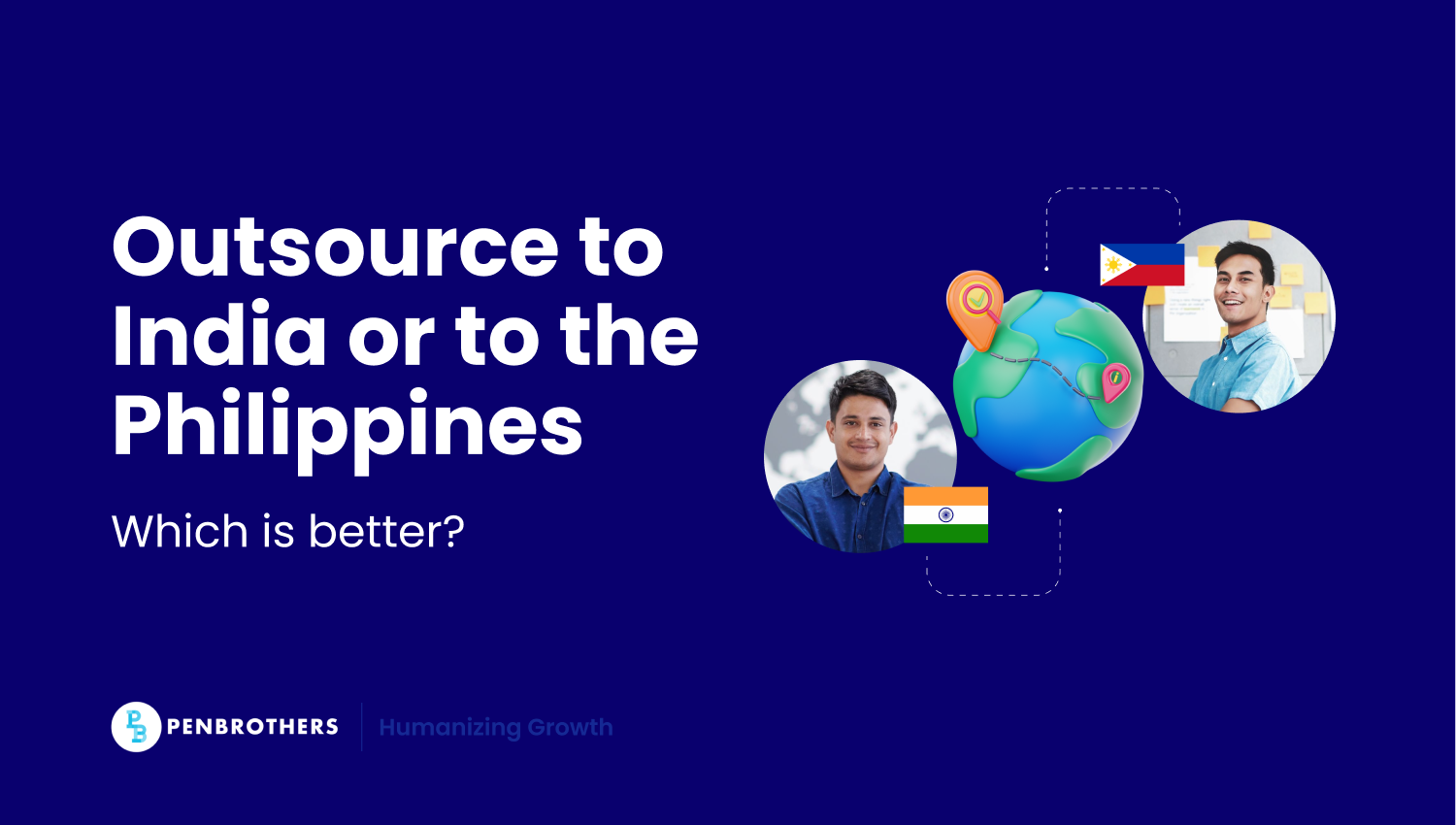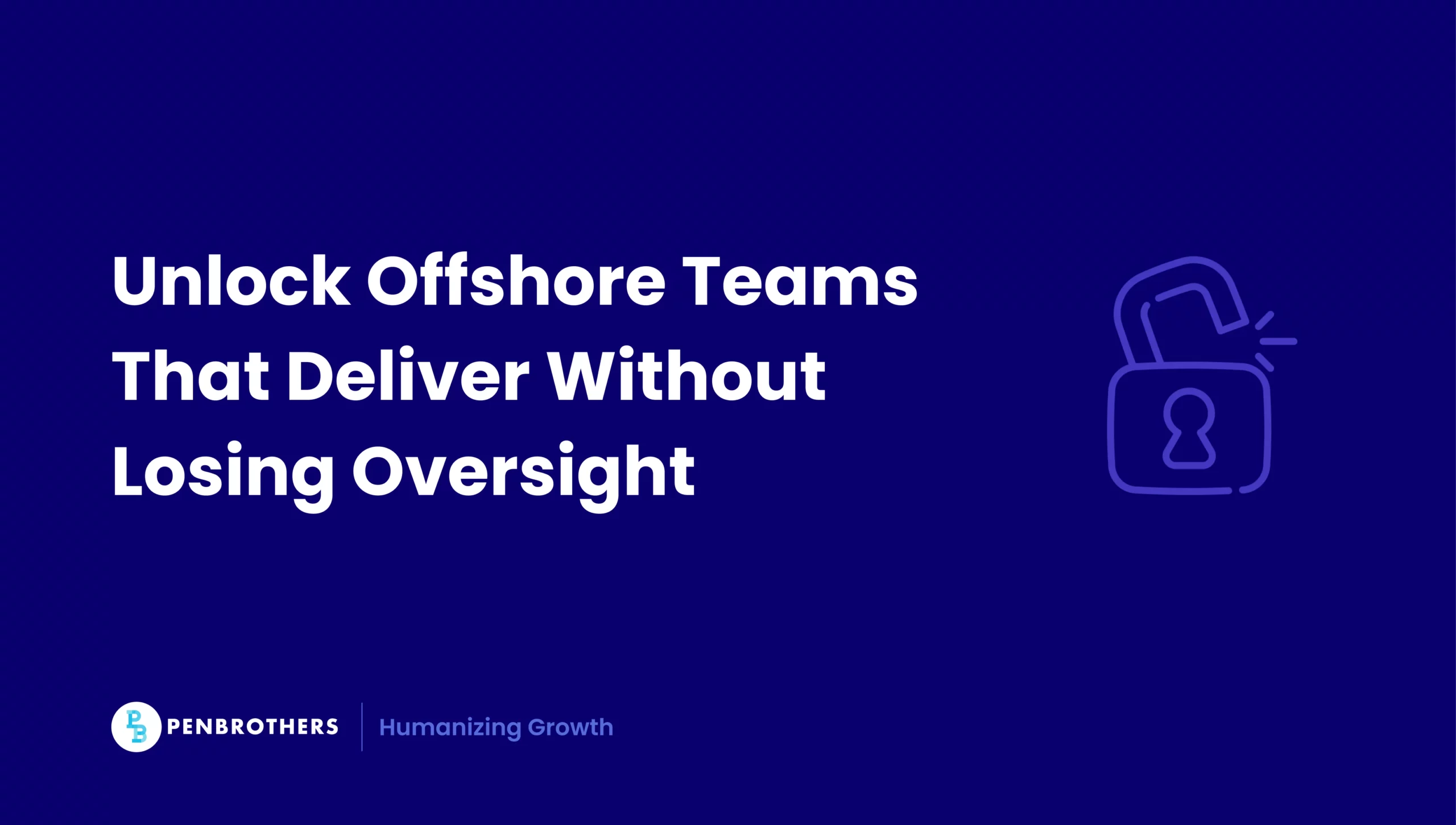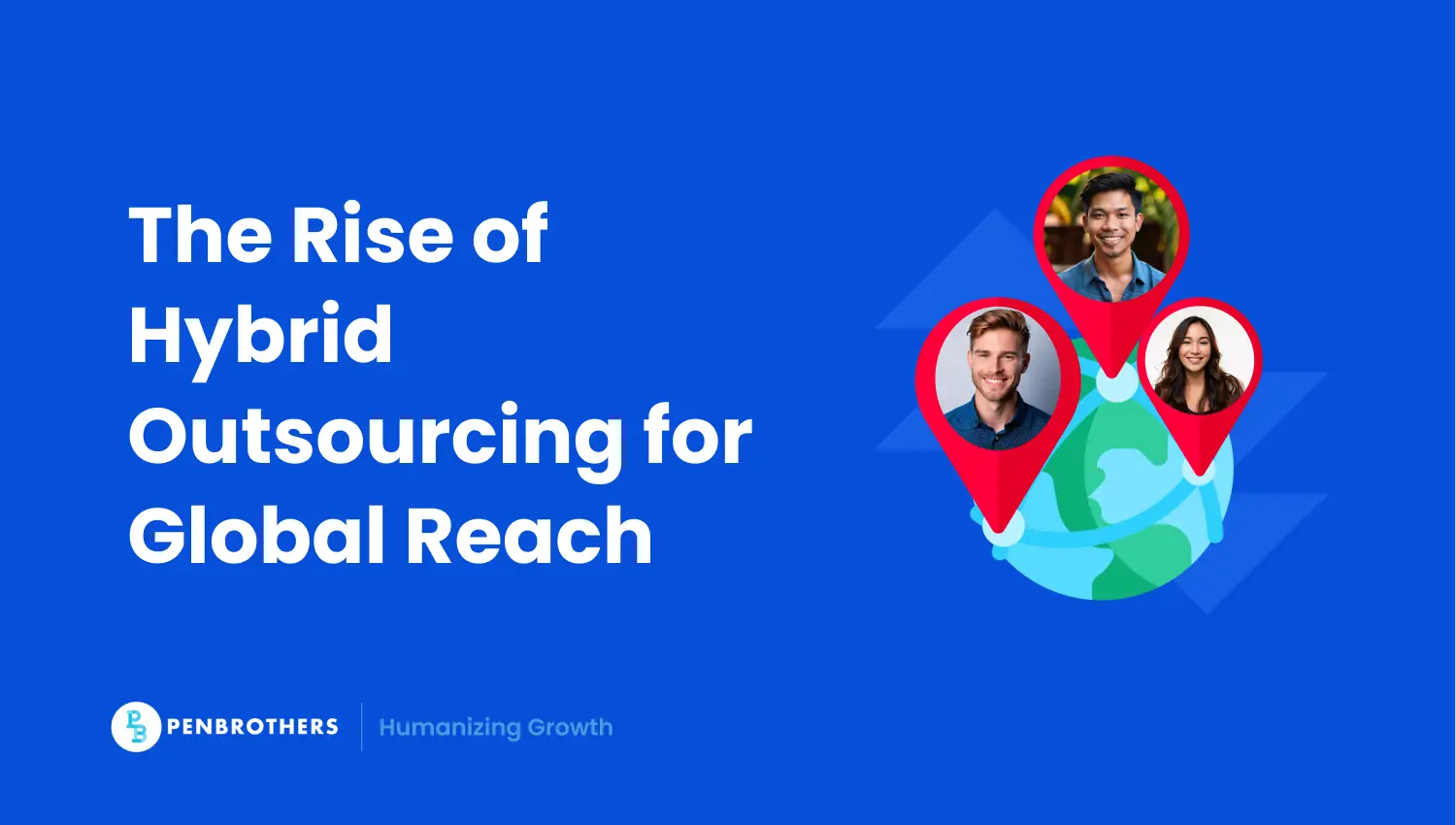What's Inside?
Philippines vs India Outsourcing: The Executive’s Guide to Strategic Partnerships

A CEO in Austin stares at two vendor proposals. The Indian firm promises 60% cost savings. The Philippine team offers 45% savings and includes something called ‘Hypercare Framework.’ The decision deadline is tomorrow.
The question isn’t which costs less.
It’s what enables sustainable growth without operational headaches.
When executives evaluate India vs Philippines outsourcing decisions in 2025, they’re not just choosing between two countries. They’re selecting the foundation for international expansion, the backbone of customer experience, and the partner that will either accelerate growth or create endless management overhead.
This choice has become more complex.
More consequential.
Key Takeaways
- It’s About Partnership Quality, Not Just Geography: The most critical factor in a successful outsourcing relationship is the quality and strategic alignment of the partner, not simply the country you choose. An exceptional partner in either India or the Philippines will deliver better long-term value.
- Each Country Has Clear, Distinct Strengths: The choice should be based on your specific business needs. India excels in large-scale, complex IT projects due to its massive technical talent pool. The Philippines is superior for customer-facing roles and operations requiring high-level English communication and cultural fluency.
- Look Beyond Base Salary to Total Partnership Cost: A simple salary comparison is misleading. The total cost of a partnership includes hidden expenses like additional training, management overhead due to communication challenges, and currency volatility. The Philippines often presents a more stable and predictable long-term cost structure.
- The Focus Has Shifted to Strategic Capabilities: Outsourcing in 2025 is no longer just about cost arbitrage. It is a strategic tool for building capabilities, ensuring operational resilience, and integrating new technologies like AI. The decision should be driven by which partner can best help you achieve these strategic outcomes.
The Outsourcing Decision That Defines Growth
Why 2025 Changes Everything
The outsourcing game has shifted. Companies now spend $904 billion globally on outsourcing services, but the focus has moved beyond simple cost arbitrage to strategic capability building. The pandemic taught executives that operational resilience matters more than penny-wise procurement.
Consider this striking statistic: 44% of chief intelligence officers are now willing to exchange data with outsourcing firms despite known security reservations. This represents a fundamental shift in how businesses view offshore partnerships: from necessary evils to strategic enablers.
The emergence of AI integration and compliance complexity has redefined partner selection entirely. Companies don’t just need hands to execute tasks; they need partners who can evolve with regulatory changes, implement new technologies, and maintain quality during rapid scaling phases.
Beyond the Binary Choice
Current market positions tell an interesting story. India dominates with 65% of the global BPO market share, while the Philippines holds 15% of the market. But market share doesn’t predict individual company success.
The Philippines has achieved 40-50% growth in the last three years, making it one of the fastest-growing outsourcing markets globally. This growth isn’t random. It reflects a strategic shift toward quality-focused partnerships over volume-driven vendor relationships.
Geographic thinking limits strategic potential. The best companies focus on finding partners who become extensions of their teams, regardless of location. They evaluate capabilities, cultural alignment, and long-term strategic value rather than simply comparing hourly rates.
Market Reality Check: What the Numbers Actually Tell Us
The True Cost Analysis (2025 Data)
Here’s where most executives get tripped up: they focus on salary differentials without calculating total partnership costs.
Virtual assistants in the Philippines earn $4,344-$7,236 annually, while Indian VAs make $2,196-$4,512. On paper, India looks cheaper. In practice, hidden costs often eliminate these savings.
Training and onboarding represent the first hidden expense. Philippine professionals often require less cultural orientation due to Western business familiarity, reducing initial investment. Indian teams may need more extensive communication training for client-facing roles, adding to upfront costs.
Time zone coordination creates another layer of expense. India operates 10-12 hours ahead of U.S. business hours, while the Philippines runs 12-16 hours ahead. Both require schedule adjustments, but the Philippines’ alignment with overnight U.S. operations often enables true 24/7 coverage without expensive overlap requirements.
Currency stability impacts long-term planning. The Indian Rupee experiences more volatility than the Philippine Peso, introducing financial unpredictability that affects budgeting and contract negotiations. This stability advantage isn’t reflected in hourly rates but becomes significant over multi-year partnerships.
Growth Trajectories and Market Maturity
India’s mature $300-350 billion market offers stability and established processes. The country has built comprehensive infrastructure over decades, creating predictable service delivery models. This maturity brings advantages: proven methodologies, extensive vendor networks, and standardized quality frameworks.
The Philippines’ rapid growth trajectory presents different opportunities. The country’s BPO sector is projected to reach nearly $40 billion by 2025, representing continued acceleration rather than maturation. This growth enables more flexible partnership structures and innovative service delivery models.
Market maturity affects strategic options differently. Mature markets offer proven solutions but limited customization. Growing markets provide flexibility but require more partnership development. The choice depends on whether you need established processes or customized solutions.
The Compliance and Security Reality
The Hidden Risk That Tanks Partnerships
Here’s the statistic that should keep executives awake: 98% of organizations work with third-parties who have experienced data breaches. In an environment where cybercrime costs are expected to reach $10.5 trillion annually by 2025, security failures cost exponentially more than salary savings.
Data sovereignty and regulatory compliance requirements have become deal-breakers. 60% of executives agree that cyber and privacy regulations effectively reduce risk, but only when properly implemented. Both India and the Philippines have developed compliance frameworks, but execution varies significantly by provider.
Indian providers have longer compliance track records, with many achieving ISO 27001, HIPAA, and GDPR certifications years ago. However, the sheer scale of India’s market means quality varies dramatically between providers.
Philippine providers have invested heavily in compliance infrastructure recently, often implementing more current security standards from the ground up. This newer approach sometimes results in more robust frameworks than legacy implementations.
The critical factor isn’t geography. It’s the specific provider’s security posture and compliance commitment. A security failure with a cheap provider can cost more than years of salary savings with a premium partner.
Infrastructure for Strategic Operations
Real connectivity data reveals significant differences. The Philippines averages 87 Mbps fixed broadband speeds compared to India’s 25 Mbps median. This isn’t just about video call quality—it affects real-time collaboration, file sharing, and system integration capabilities.
5G rollout impact varies between countries. India’s 5G implementation has improved mobile speeds but fixed broadband infrastructure remains inconsistent outside major cities. The Philippines’ infrastructure development focuses on business districts and outsourcing hubs, creating more reliable connectivity for commercial operations.
Government digital initiatives matter for long-term partnership planning. The Philippines’ Digital Cities 2025 initiative specifically targets infrastructure development for outsourcing operations. India’s broader digital infrastructure programs serve multiple sectors but may not prioritize outsourcing-specific needs.
Why infrastructure affects more than technical operations: consistent connectivity enables complex project coordination, real-time problem solving, and seamless integration with client systems. Poor infrastructure creates communication friction that compounds over time.
Operational Excellence vs Technical Capability
The Communication Advantage
Updated English proficiency data tells a clear story. The Philippines ranks 20th globally with a score of 578, while India ranks 60th with 504 on the EF English Proficiency Index. This difference isn’t about basic communication—it’s about nuanced understanding, cultural context, and complex project discussions.
Communication quality directly impacts project velocity. Teams that understand requirements clearly execute faster with fewer iterations. They ask better questions, provide more useful updates, and identify potential issues before they become problems.
Cultural alignment accelerates strategic initiatives. Philippine professionals’ familiarity with Western business practices reduces the learning curve for company-specific processes, client expectations, and industry standards. This alignment becomes crucial for client-facing roles and complex project coordination.
The accent neutrality factor affects customer experience metrics. For customer service operations, clear communication directly correlates with satisfaction scores, resolution times, and brand perception. The difference between ‘good enough’ and ‘excellent’ communication often determines long-term partnership success.
Technical Depth and Specialization
India maintains significant advantages in technical depth. The country produces approximately 4 million STEM graduates annually, creating an unmatched talent pool for complex software development, data science, and engineering projects.
Indian educational institutions have decades of experience producing technically skilled professionals. The curriculum focuses heavily on mathematics, computer science, and engineering fundamentals. This foundation supports complex technical projects that require deep analytical thinking and advanced problem-solving capabilities.
The Philippines has evolved beyond basic service delivery into complex technical roles. Government investments in IT education and specialized training programs funded by $157 million in skills development have expanded the available skill sets significantly.
Philippine technical professionals excel in areas requiring both technical skills and communication abilities: technical support, user experience design, digital marketing, and client-facing development roles. The combination of technical competence and communication skills creates unique value for certain project types.
Strategic Partnership Models
Vendor Management vs Partnership Development
Penbrothers’ Hypercare Framework represents a fundamental shift from traditional vendor relationships to strategic partnerships. Instead of simply providing resources, effective offshore partners become extensions of your team, understanding your business goals, culture, and growth trajectory.
Exceptional partners transcend geographic limitations through strategic alignment. They invest in understanding your industry, your customers, and your competitive landscape. They proactively suggest improvements, identify opportunities, and adapt their services as your business evolves.
Building capabilities that evolve with your business requires partners who view the relationship as long-term investment rather than transactional arrangement. This mindset shift affects everything from talent recruitment and training to technology investment and process optimization.
Traditional vendor relationships focus on task completion and cost reduction. Strategic partnerships focus on outcome achievement and capability building. The difference becomes apparent during scaling phases, market changes, and strategic pivots.
Scaling Challenges and Solutions
Quality maintenance during rapid expansion represents the biggest challenge in offshore partnerships. Many relationships succeed at small scale but break down when volume increases or requirements become more complex.
Successful scaling requires systematic approaches to talent acquisition, training standardization, and quality assurance. Partners who have developed these systems can maintain consistency during growth phases. Those who haven’t typically experience quality degradation that damages the relationship.
The hidden costs of vendor relationship management compound over time. Multiple vendor relationships require coordination overhead, quality monitoring, and performance management. Strategic partnerships with fewer, higher-quality providers often prove more cost-effective than managing numerous vendor relationships.
Long-term strategic alignment requires partners who understand your business trajectory and can adapt their capabilities accordingly. This might mean investing in new technologies, developing specialized skills, or expanding service offerings to support your growth.
Industry-Specific Considerations
Where Geography Still Matters
For software development and complex IT projects, India’s technical depth provides significant advantages. The country’s established educational system, extensive experience with enterprise software, and large pool of specialized developers make it particularly strong for technical projects requiring deep expertise.
Customer-facing operations benefit from the Philippines’ communication advantages. Call centers, customer support, virtual assistance, and any role requiring direct client interaction typically performs better with Philippine teams due to language proficiency and cultural alignment.
Emerging sectors present interesting considerations. AI and machine learning projects often favor India’s technical foundations, while healthcare support and financial services may benefit from the Philippines’ regulatory compliance focus and communication skills.
The key insight: match your specific requirements to each country’s natural strengths rather than making broad geographic assumptions.
Future-Proofing Your Decision
Automation affects both markets differently. India’s focus on technical roles positions it well for AI integration and advanced automation projects. The Philippines’ emphasis on human-centric services creates opportunities in areas where automation complements rather than replaces human expertise.
Regulatory trend implications favor providers who stay ahead of compliance requirements. Both countries have developed strong regulatory frameworks, but implementation varies by provider. Choose partners who demonstrate proactive compliance management rather than reactive approaches.
Building resilience into offshore strategies requires diversification considerations, but not necessarily geographic diversification. Partner quality and capability breadth often matter more than location spread. A single exceptional partner may provide more resilience than multiple mediocre vendors across different countries.
The Executive Decision Framework
Evaluation Criteria That Actually Matter
Moving beyond cost per hour to value per outcome requires metrics that reflect business impact. Consider time-to-market improvements, quality scores, customer satisfaction metrics, and strategic contribution measures rather than just hourly rates.
Partnership sustainability indicators include team retention rates, process improvement suggestions, proactive communication, and investment in capability development. Partners who demonstrate these characteristics typically deliver better long-term value.
Red flags that predict relationship failure: excessive focus on cost reduction, reluctance to provide references, lack of investment in employee development, poor infrastructure, and transactional communication styles. These indicators often signal fundamental misalignment in partnership approach.
Quality partnerships require investment from both sides. Providers who offer significantly below-market rates often cannot sustain quality service delivery. Extremely low costs usually indicate shortcuts in training, infrastructure, or employee retention that create long-term problems.
Implementation Strategy for Success
Pilot program design enables risk mitigation while testing partnership potential. Start with well-defined, measurable projects that allow evaluation of communication, quality, and cultural fit before making larger commitments.
Performance measurement and optimization requires clear metrics established upfront. Define success criteria, communication expectations, and quality standards explicitly. Regular review and adjustment periods help optimize the relationship over time.
Building internal capabilities for partner management ensures you can effectively coordinate offshore relationships. This includes project management skills, cultural awareness, and clear communication protocols. Many partnerships fail due to poor internal management rather than provider issues.
The Strategic Choice
Why the Best Companies Focus on Partners, Not Places
Exceptional partnerships transcend geographic limitations through shared commitment to mutual success. The best offshore relationships feel like extensions of internal teams rather than external vendor arrangements.
The compound value of cultural alignment and process excellence becomes apparent over time. Teams that understand your business context, customer needs, and quality standards deliver exponentially better results than those focused solely on task completion.
Building relationships that scale with international growth requires partners who can support expansion into new markets, adapt to changing requirements, and maintain quality across multiple locations or service lines.
Geographic focus limits strategic thinking. The most successful companies identify partners who align with their values, understand their business, and commit to long-term success, regardless of location.
Making the Decision That Enables Growth
Key questions for strategic evaluation: Does this partner understand our business goals? Can they adapt as we grow? Do they proactively suggest improvements? Will they represent our brand well to customers? Do they invest in our success?
Rushing the decision costs more than thorough evaluation. Take time to assess cultural fit, communication quality, and strategic alignment. The partnership you choose will affect your operations for years—invest in the selection process accordingly.
The importance of alignment over geography cannot be overstated. A perfectly aligned partner in either India or the Philippines will outperform a misaligned partner in your preferred location. Focus on finding the right partner, then work together to optimize the relationship.
The Partnership That Transforms Operations
The India vs Philippines outsourcing debate misses the fundamental point: geography matters far less than partnership quality. The most successful offshore relationships happen when companies find partners who understand their vision, share their commitment to excellence, and contribute to strategic growth rather than simply reducing costs.
Whether your ideal partner operates from Mumbai or Manila depends on your specific needs, but the characteristics of exceptional partnerships remain consistent: deep business understanding, cultural alignment, proactive communication, and genuine commitment to your success.
The executives who build the strongest offshore relationships don’t choose countries—they choose partners who happen to be located in strategic markets. They focus on capabilities, cultural fit, and long-term value creation rather than hourly rates and geographic preferences.
If you’re ready to move beyond vendor relationships toward strategic partnerships that accelerate your international growth, the next step isn’t choosing a country. It’s finding a partner who understands your vision and can help you achieve it. Let’s discuss how the right offshore partnership can transform your operations and support your expansion goals.
Frequently Asked Questions
The primary difference lies in their core strengths. India offers unparalleled scale and deep technical expertise, making it ideal for complex, large-scale IT and engineering projects. The Philippines excels in customer-facing roles and communication-heavy tasks due to its workforce’s high English proficiency and strong cultural alignment with Western businesses.
While India may have lower base salaries for some roles, this does not represent the full picture. The total cost of partnership must be considered, which includes hidden costs like extra training and management overhead for communication. The Philippines often provides a more predictable and cost-effective solution when all factors are included.
The Philippines holds a significant advantage in this area. It ranks 20th globally on the EF English Proficiency Index, whereas India ranks 60th. Filipino professionals are known for their accent neutrality and deep cultural fluency, which is a major benefit for customer service and other client-facing roles.
India is generally the stronger choice for large-scale, technically complex software development. The country has a massive talent pool with millions of STEM graduates annually and a mature IT industry with deep experience in enterprise-level projects.
The most important factor is the quality and strategic fit of the specific partner, rather than the country itself. The focus should be on finding a provider who understands your business goals, aligns with your culture, and can deliver the specific outcomes you need, regardless of their location.




